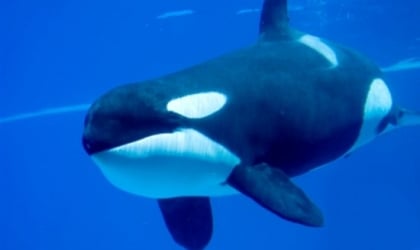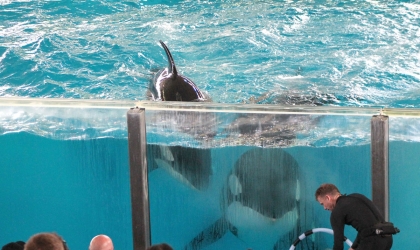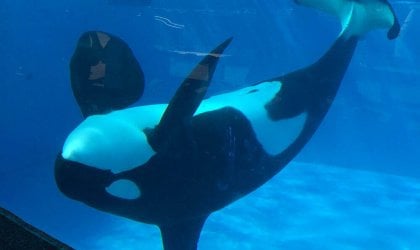In November 2020, PETA Foundation veterinarian Dr. Monica Bando visited SeaWorld Orlando to revisit the animals’ living conditions following another investigation. What she found was a water-prison full of animals suffering psychologically and likely enduring physical pain as well as being placed at risk of exposure to deadly diseases.
SeaWorld staff were letting visitors touch dolphins and feed sea lions, putting the animals at risk of contracting all sorts of diseases during a pandemic. No one even seemed to be required to wash their hands before interacting with the animals, who were forced to engage in multiple encounters throughout the day.

The U.S. Department of Agriculture (USDA) has recognized that it’s not just humans who can contract the novel coronavirus, issuing a notice advising that hands-on encounters with big cats be suspended and saying that “[m]embers of the public should maintain a distance … from [them],” as “the animals used for hands-on public contact could … be a vehicle for infecting people coming in direct contact with [them].” Minks, dogs, and domestic cats can also contract the virus. Recent studies show that whales, dolphins, and seals are “highly susceptible” to novel coronavirus infection, which could cause life-threatening liver and lung damage. Large crowds of people who haven’t been consistently social distancing and have been potentially touching contaminated surfaces could easily spread the virus to each other and to animals and trainers.

This sort of negligence not only is problematic but also is apparently in violation of the federal Animal Welfare Act (AWA). SeaWorld has seemingly failed to exhibit animals “under conditions consistent with their good health and well-being” and failed to handle animals “so there is minimal risk of harm to the animal and to the public.” Dr. Bando also noticed that some visitors weren’t wearing masks properly and that others weren’t wearing them at all. One visitor pulled their mask down briefly during a dolphin encounter, and an employee kept his mask on his chin for an extended period of time while giving a tour to customers.

And these cruel encounters aren’t the worst of it, not by a long shot. Dr. Bando found that many of the marine mammal exhibits were small and devoid of sufficient enrichment or complexity to meet the physical, behavioral, and mental needs of the animals trapped in them. Several species, including some dolphin and pinniped species, did not appear to have areas where they could fully retreat from the public nor sufficient shelter from the elements. These highly intelligent, autonomous animals are being forced to live in small, empty enclosures for their entire lives, and these artificial conditions simply can’t meet their needs.
There was no environmental enrichment in two dolphin enclosures, and only one of the two harbor seal exhibits had a single red plastic item. Imagine having only a single plastic device to entertain you and all your cellmates and enduring a miserable and empty life that is actually an upgrade compared to the life of those in the other exhibit who have nothing.
Dr. Bando observed several other heartbreaking things, including the following:
- Two orcas had worn or fractured teeth and exposed pulp (the soft area in the center of the tooth containing the nerve, blood vessels, and connective tissue).

Dental trauma like this is common in captive orcas, who gnaw on the sides and gates of their tanks. The condition can be painful and puts the animals at risk of infection, and it requires regular cleaning and maintenance.
- Rake marks were present on several dolphins and at least one orca.

In nature, aggressive encounters can be de-escalated when a subordinate animal simply leaves. But at SeaWorld, the inadequate enclosures increase aggressive behavior and prevent the animals from escaping attacks—including one enclosure that housed more than 15 dolphins.
- Male orcas regurgitated and then re-ingested their food, which is a common stereotypic behavior of captive orcas that can cause chronic irritation and ulceration in their esophagi.
- Two walruses in a small enclosure were engaged in stereotypic lap-swimming behavior.
- At least one dolphin had multiple poxvirus lesions, which are often brought on or made worse by stress and environmental factors.

- Harbor seals, sea lions, and other pinnipeds, some with open wounds on their flippers, exhibited aggression when competing for fish tossed into the enclosure by visitors.
- One walrus with an apparent eye problem was observed repeatedly diving and remaining head-down in the water for one or two minutes at a time before resurfacing, at which point his left eye appeared to spasm or flicker—which can indicate ocular pain.
Captive pinnipeds commonly suffer from ocular damage caused by being exposed to unnatural levels of sunlight from frequently looking up for food tossed into their enclosures. Nothing about life in captivity is natural.

SeaWorld has clearly failed when it comes to protecting animals from trauma and preventing their physical harm and unnecessary discomfort. But none of this comes as any surprise when sentient beings who want to be free are subjected to unnecessary, undeserved, and never-ending imprisonment. SeaWorld does a poor job of even pretending to care about the animals it sentences to a lifetime of deprivation.
PETA is calling on the USDA to investigate these concerns promptly and hold SeaWorld accountable for any and all violations of the AWA (and common decency) that it finds.




